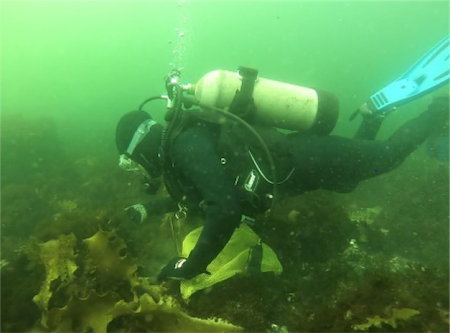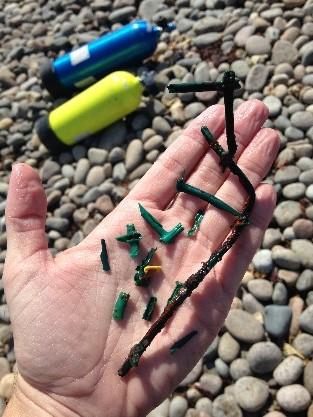This is a guest blog post from the Massachusetts Office of Coastal Zone Management (CZM), written by Claudia Geib.
Video: Underwater Coastsweep Cleanup at Rockport
Skip this video Underwater Coastsweep Cleanup at Rockport.Volunteering for Coastsweep
It was a cool, sunny day in Rockport in late September, and breathing compressed air 20 feet below the surface, I was starting to get a little worried — I was part of an underwater cleanup for COASTSWEEP, but I hadn’t found any trash yet.
I had spent the last four months writing, reading, and tweeting about how much marine debris is in the ocean and on the coasts — but now that I was actually underwater looking for it, where were all the plastic bottles, old tires, and rusted cans? The rocky reef we were swimming over was coated in colorful, healthy-looking marine life: pale purple crabs, craggy white cold-water coral, delicate magenta starfish, massive orange and blue spotted lobsters as big as a small dog. It seemed like this beautiful ecosystem was untouched by human trash.
But after a few minutes, I spotted my first COASTSWEEP find — a tiny piece of bright green plastic, half-hidden in the rocks. I almost immediately spotted another, a yellow shard of plastic nestled in the sand. Because I was looking for big, easy-to-see debris, I had almost missed the trash that was really there.
Plastics make up 90 percent of the trash recorded in our oceans and on our coasts. But it’s easy to miss if you’re walking down a beach or scuba diving a reef. Plastic tends to break into smaller and smaller pieces when it’s in the ocean, even to the size of a grain of sand, called “microplastic.” While these bits of manmade material are tiny, they can have a big impact. Pieces of plastic absorb toxins, such as aromatic hydrocarbons — found in oil and gasoline — and polychlorinated biphenyls (PCBs) — chemicals that the EPA has found cause cancer. Animals often mistake them for food and suffer serious consequences. Because plastic cannot be digested, the pieces sit in the animal’s stomach and make it feel full, so it stops hunting and eating while the toxins in the plastic slowly poison the animal.
Volunteering for an underwater COASTSWEEP cleanup showed me firsthand just how widespread the plastic pollution problem is — and that helping clean our shores can be really fun.
We spent two hours underwater in Rockport. We collected dozens of pieces of small plastic, as well as bits of rubber, metal, and cigarette butts hidden in the reef. Looking for trash on the ocean floor felt like participating in an underwater scavenger hunt — and we got to see an amazing assortment of marine life. We emerged from the water that afternoon tired and chilly, but with giant smiles, knowing that we had helped preserve the Massachusetts coast.
Visit the COASTSWEEP website to find out how you can volunteer for an existing cleanup or organize an event of your own. If you’re interested in taking up scuba diving, check out dive sites in the Bay State and tips on how to get started at the CZ-Tip: Scuba Diving in Massachusetts page.

